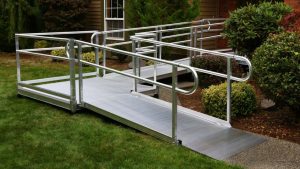Key Factors to Consider When Installing Residential Accessibility Ramps
When it comes to installing residential St. Petersburg accessibility ramps, there are a few key factors that you should consider. These factors include cost, slope ratio, and platform lifts.
If you are looking to add an accessibility ramp to your home, you will need to consider a number of factors. These include cost, quality, ease of use, and more. The right solution can be invaluable to people in wheelchairs.

A modular residential accessibility ramp is a popular option. It is easier to install and reuse than a more complicated structure. They also offer flexibility in design. You can buy different colors or powder coat finishes to match your home. Choosing the best model for your needs is important.
There are many different types of ramps. Some are made of wood, while others are metal. Metal ramps are usually modular. In addition, they are more aesthetically pleasing than wooden ramps.
The first step in installing a modular ramp is to determine the length you need. This is dependent on the size of your mobility equipment.
If you are trying to find a more permanent solution for home accessibility, you may want to consider installing a platform lift. These lifts are easy to use and provide a great deal of safety. They can be installed inside or outside the home.
Several different models are available. Some are self-installed, while others require professional installation. Platform lifts are a more durable solution than ramps and can be installed to fit a variety of spaces.
Choosing the right St. Petersburg platform lift for your home can be a difficult task. You must consider the cost, size, and location of the stairs. In addition, you should also factor in the maintenance costs.
The PASSPORT is known as the lightest residential platform lift. It features Plug-N-Play wiring technology, making it low-maintenance and user-friendly.
When you are installing a ramp, it is important to consider the handrails you are going to use. These are designed to provide a secure grip, which is crucial to protecting people from injury. In addition, they should be able to accommodate the mobility of those who use them.
Handrails should be continuous and parallel to the ground. They should also be free from sharp elements. Additionally, the top of the handrail should be 34 to 38 inches above the walking surface.
Handrails should be made of rounded material. If the handrail is non-circular, the cross-section must be no more than 2 1/4 inches. The perimeter of the handrail should be 4 to 6 inches.
Handrails for ramps must be free of interruptions, such as doglegs (180-degree turns at the landing). The end of the handrail should also be smooth and returned smoothly to the floor.
When installing residential accessibility ramps, the slope ratio you use should be measured carefully. There are many options for ratios, and it is best to check your local building codes to find out what is recommended in your area.
The American with Disabilities Act (ADA) recommends a slope ratio of at least one to twelve inches, but this isn’t a mandatory requirement. If you’re unsure, ask your home access provider or a qualified ramp professional.
One of the easiest ways to determine the proper length of your ramp is to use a calculator. These calculators can be found online. You should also have a tape measure handy. Once you have these pieces of information, it will be much easier to figure out the length you need.
Another option is to measure the incline of the ramp. This is calculated by dividing the arctangent of the b and c.
The cost of residential accessibility ramps depends on several factors. Aside from material costs, the length of the ramp and the slope of the ramp are also determining factors. In general, prices range from $50 to $250 per linear foot of the ramp.
Home ramps are an important safety measure for many residents. They allow people with mobility difficulties to fully participate in the community. However, it is important to understand the accessibility requirements before building or purchasing a ramp.
A permanent ramp can be built from materials such as concrete, aluminum, and wood. It is an affordable and durable solution for homes. However, it may require a building permit.
Modular and semi-permanent ramps are another type of accessible home solution. They are prefabricated, can be installed by a contractor, and are relatively quick and easy to install.